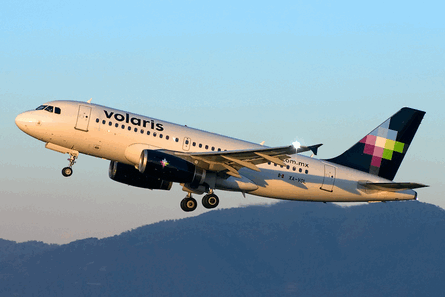Mexico's dynamic market is starting to show signs of recovery and profitability after a tumultuous two years which netted five airline casualties.
Almost every Mexican carrier has been in the red since 2007 due to intense competition driven by the launch of five new carriers. Last year was particularly bad as the economic downturn and the H1N1 outbreak drove down traffic and yields despite a double-digit capacity reduction.
But year-to-date traffic is now tracking slightly ahead of 2009 levels and more importantly yields have improved. Aeromexico CEO Andres Conesa says the carrier was back in the black in the first half of 2010 and is off "to the best start of the year in maybe 10 years".
Conesa credits improving market conditions and an aggressive restructuring, which included a series of capacity, fleet and job cuts in 2009: "We are in much better shape today than before the crisis started last year."
 |
|---|
" We are [now] the Latin American carrier for SkyTeam. We have the largest presence in the region"Andres Conesa, Aeromexico |
VivaAerobus chief executive Juan Carlos Zuazua adds: "2010 is a much better year than 2009 and 2008 for us and the whole industry."
But while conditions have clearly improved the Mexican market has not yet completely weathered the storm and most players acknowledge further consolidation is needed before profits can be sustained over the long-term.
Garza predicts there is only room for one flag carrier, one or two domestic trunk carriers and one or two regional carriers. Currently there are two flag carriers in Aeromexico and Mexicana and three domestic trunk carriers in Interjet, Volaris and VivaAerobus. There are also four regional carriers when including Aeromexico Express, Mexicana subsidiaries Click and Link and independent operator Aeromar. But with a long-mooted Aeromexico-Mexicana merger currently not being considered and with Volaris earlier this year rejecting a takeover bid from Interjet, it is unlikely there will be any further consolidation in the Mexican market in the near-term.
"It looks like it will be a longer more complicated process. We tried to influence the dynamics rather than waiting, but it didn't happen," Garza says. "We've responded by resuming our original business plan."
Interjet in July resumed domestic expansion after an 18-month hiatus, placing two additional A320s into service for a total fleet of 17 aircraft. Garza says Interjet now plans to use the four additional A320s it will receive next year to launch international services as it focuses on moving to the next phase of its organic expansion plan following its failed attempt to acquire rival Volaris.
Garza says the proposed merger would have resulted in more consolidation in the Mexican domestic market "and probably the elimination of one of the brands". Volaris is a similar sized Mexican low-cost carrier also operating A320s. But while Interjet currently only operates domestic services Volaris serves three international destinations, all in California, with ambitious plans to expand its US network and begin codesharing with Southwest Airlines.
Volaris is also planning to resume fleet expansion after a two-year hiatus with two additional A319s to be delivered later this year, giving it a fleet of 23 aircraft. The carrier, which has been able to launch US services over the last year by reducing domestic capacity, is also in the process of completing an internal ownership reorganisation.
Two of Volaris' four owners are expected to exit after they elected to accept the Interjet takeover offer. The carrier's other two owners - Avianca-TACA chairman and shareholder Roberto Kriete and Discovery America's Pedro Aspe - are expected to increase their stakes as they both decided to reject the Interjet offer and instead exercise their option to buy out their two partners. But new shareholders may also enter because Mexico requires 70% local ownership and Kriete is not a Mexican citizen.
 |
|---|
Volaris is returning to growth by adding two more A319s this year |
Zuazua claims VivaAerobus is primarily in different markets than Interjet and Volaris and follows a purer low-cost market, which should help the smaller carrier survive the next round of consolidation.
Aeromar also has decided to resume expansion and is preparing to place into service two Bombardier CRJ200s in the fourth quarter to supplement its current fleet of 14 ATR 42 turboprops. Aeromar president Ami Lindenberg says Mexico's domestic market has still not fully recovered from the crisis of the last two years but "we see a small recovery and we see new opportunities. That's why we decided to do it [add regional jets] now. This is the correct time. We see the current crisis is less severe than a year ago and we hope to have no new crisis and expect the real recovery will begin in 2011."
Lindenberg says Aeromar also has forged a new codeshare partnership with Continental Airlines which will take effect by early September. The codeshare helps Continental fill the void left by its partnership with Aeromexico, which ended late last year after Continental left SkyTeam for Star. Aeromar currently has an extensive codeshare arrangement with oneworld's Mexicana which Lindenberg says will continue despite the new tie-up with Continental.
Mexicana says it plans to grow capacity by 10% this year while Aeromexico says in May it started restoring some capacity to the US, where it cut capacity by almost 20% last year. Aeromexico is also redirecting some of its prior US capacity to Latin America. The carrier so far this year has launched services to Costa Rica, Colombia and Cuba and Conesa says it aims to add Panama in early 2011.
Conesa explains Aeromexico's new focus on Latin America helps SkyTeam fill the gap left when the alliance's only other Latin member, Copa, exited with Continental last October: "Once Continental and Copa left SkyTeam some of those countries were left uncovered. We are [now] the Latin American carrier for SkyTeam. We have the largest presence in the region. We not only have a big presence in Mexico we want to strengthen our network in Central and South America. It's a win-win for us and the other members of the alliance."
Source: Airline Business
















